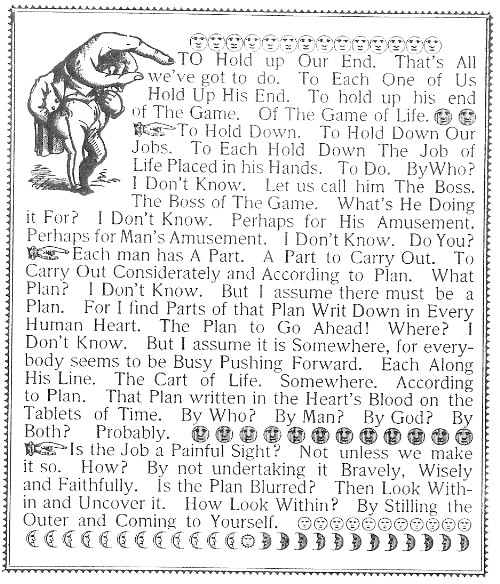Mind over Matter: Willing Money out of Thin Air
 The “New Thought” or “Mental Cure” Movement and spiritualism were stepsisters—they both developed among practitioners of mesmerism in the mid-nineteenth century, and relied on a conviction that mind—specifically one’s own mental attitude—created, for better or worse, the material conditions surrounding oneself. In the last decades of the century, this informed a lot of “positive thinking” preachers who appealed to business and salespeople, and others engaged in what came to be called “motivational training,” especially as it was organized in the twentieth century into mind-control seminars that have turned out proselytes intent on recruiting others into expanding circles of “abundance” that heavily emphasize financial gain and personal power—and equate material wealth with virtue and material poverty with sin. An emphasis on psychic manipulation (or even creation) of material reality was a common thread that ran through spiritualism and New Thought (and Occultism, and down into our times in the New Age Movement as well as in the Christian variations of “abundance affirmations”). Many people created their spirituality in the 1870s—1900s, by mixing spiritualism, New Thought (or Christian Science), and forms of Occultism, such as Theosophy.
The “New Thought” or “Mental Cure” Movement and spiritualism were stepsisters—they both developed among practitioners of mesmerism in the mid-nineteenth century, and relied on a conviction that mind—specifically one’s own mental attitude—created, for better or worse, the material conditions surrounding oneself. In the last decades of the century, this informed a lot of “positive thinking” preachers who appealed to business and salespeople, and others engaged in what came to be called “motivational training,” especially as it was organized in the twentieth century into mind-control seminars that have turned out proselytes intent on recruiting others into expanding circles of “abundance” that heavily emphasize financial gain and personal power—and equate material wealth with virtue and material poverty with sin. An emphasis on psychic manipulation (or even creation) of material reality was a common thread that ran through spiritualism and New Thought (and Occultism, and down into our times in the New Age Movement as well as in the Christian variations of “abundance affirmations”). Many people created their spirituality in the 1870s—1900s, by mixing spiritualism, New Thought (or Christian Science), and forms of Occultism, such as Theosophy.
Many fraudulent schemes have been run on the belief that, in some sense, straw could be spun into gold in the twilight bonding of sympathetic “affinities.” Scams that were the equivalent of “Ponzi” schemes were organized on this basis before Ponzi organized his in Boston in 1919.
And investment “bubbles” and pyramid schemes were organized long before today’s New-Age-infused “gifting circles.”
Comparing one woman clairvoyant’s “Ladies’ Deposit Bank” in Boston in the 1880s to instances from today of “Women Empowering Women” (as a similarly situated “affinity group” scheme) is instructive in seeing how many characteristics they share.
The Ladies’ Deposit Brings “Sympathetic Banking” to Its Clients
California Sisters Doing It to Themselves
Many features of current schemes are already present, fully-developed, in the Ladies’ Deposit scheme of more than a century before—a willing suspension of participants’ disbelief in the impossibility of creating new money rather than pulling it out of the hands of many and placing it into the hands of a few; a quasi-religious appeal to a special women’s way of knowledge beyond the mundane logic of economics; an appeal to “progressive” philanthropy and to the notion that the scheme is a moral reform by benevolent people of the monetary system, an appeal to solidarity of the sisterhood; a view of men as oppressors and a view of doubters as colluders with sin; a characterization of women as victims; a requirement of secrecy for participants; a dependence on personal recruitment of new participants; a need to entangle friends and family; a paradoxical rationalization of the scheme as a form of charity to others with a simultaneous hope for a tremendous profit for oneself; and a continued loyalty of some of the victims to the scheme after its collapse (which these victims blame on hostile non-believers).
Note that gifting scams and ponzis appear across all ethnic groups, in both genders, among all ages, levels of education, and income, and with participants of all sorts of political and religious beliefs.
::::::::::::::::::::::::::::::::::::::::::::::::
[ Ephemera Home] [ Discovering Wealth ]